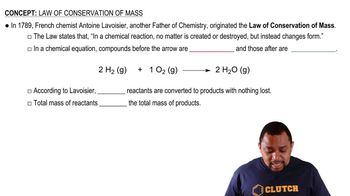Here are the essential concepts you must grasp in order to answer the question correctly.
Combustion Reaction
A combustion reaction is a chemical process in which a substance reacts rapidly with oxygen, producing heat and light. In the case of ethanol, the reaction can be represented as C2H6O + 3O2 → 2CO2 + 3H2O. Understanding this reaction is crucial for determining the products formed and the stoichiometry involved, which helps in calculating the amounts of reactants and products.
Recommended video:
Stoichiometry
Stoichiometry is the calculation of reactants and products in chemical reactions based on the conservation of mass. It involves using balanced chemical equations to relate the quantities of substances involved. In this question, stoichiometry will be used to determine the mass of ethanol in the sample by analyzing the mass of water produced during combustion.
Recommended video:
Mass Conservation
The principle of mass conservation states that mass is neither created nor destroyed in a chemical reaction. This means that the total mass of the reactants must equal the total mass of the products. In this scenario, knowing the total mass of the beverage and the mass of water collected allows for the calculation of the mass of ethanol, as the mass of the original sample must equal the sum of the masses of ethanol and water.
Recommended video:
Law of Conservation of Mass
 Verified step by step guidance
Verified step by step guidance


